
This year has flown by as many people got back to the normality of life before Covid. The John Lewis advert is out so Christmas will be with us before we know it.
Alvis related gifts are available from the Alvis Owner Club shop at logothatpolo.co.uk. The Alvis Shop at Red Triangle, redtriangle.co.uk/shop has a selection of items and particularly nice is the bespoke tool kit in canvas roll; or how about this excellent set of car related chocolates.

Don’t miss the opportunity to purchase a copy of the Alvis TA 14 50th Anniversary Collection revised edition from the AOC shop. Packed full of useful information and having just had a limited edition reprint. After they are gone you may have to try and find a second hand copy or rely on a disc. Service notes and the data sheets are just 2 of the tasty inserts that make interesting reading.

Something that is often overlooked is the importance of knowing the implications of your chassis number as highlighted by the extracts below.
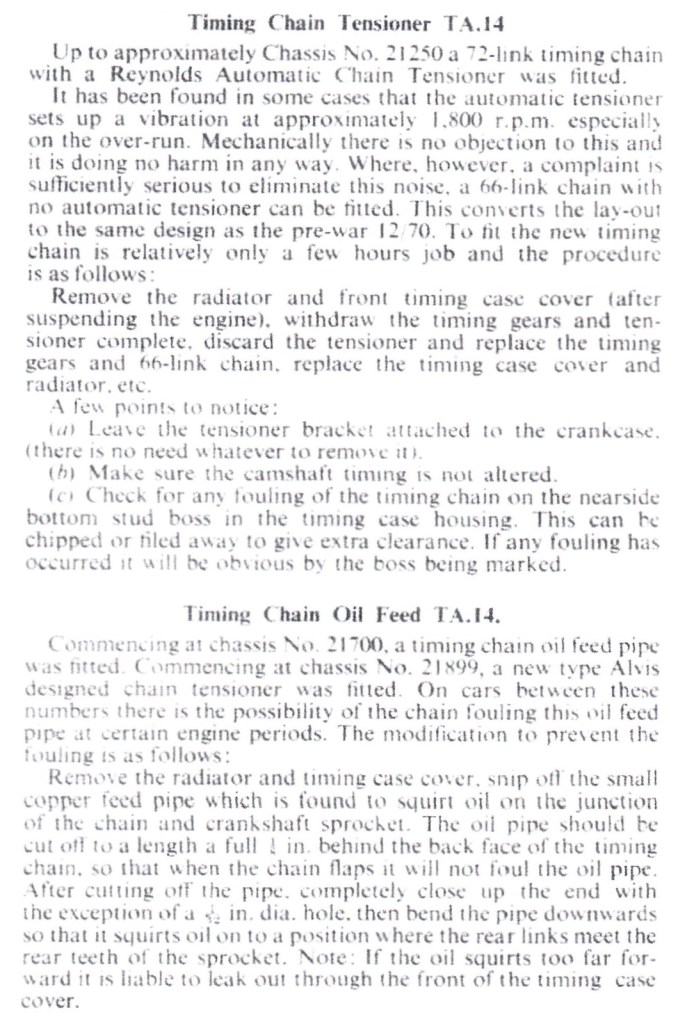
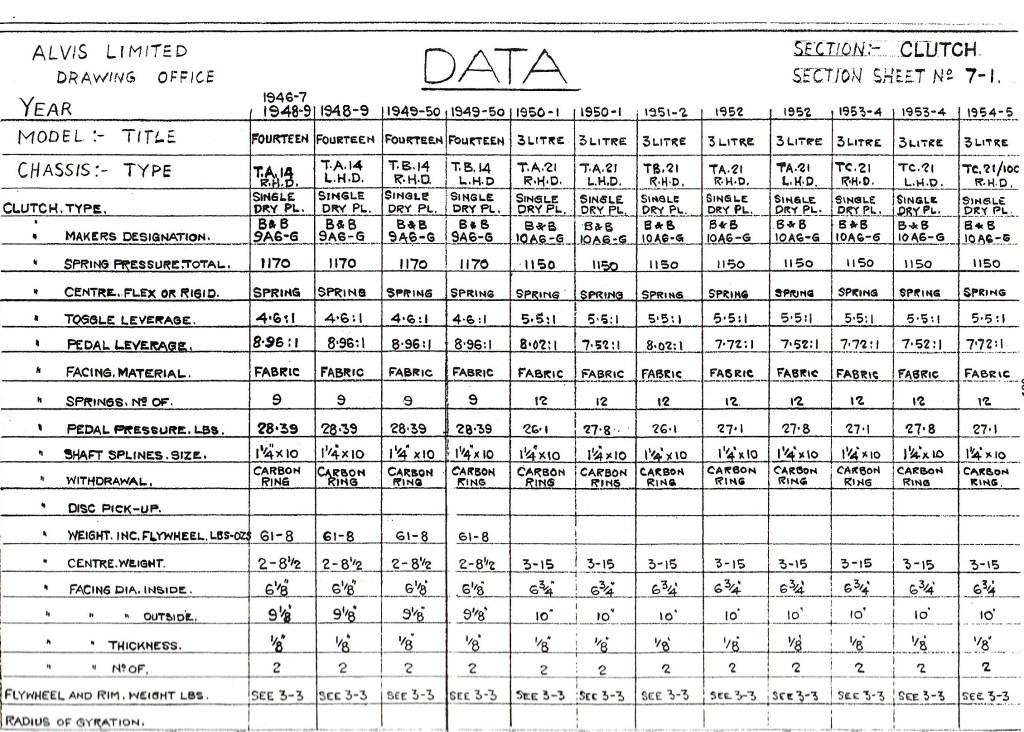
The Alvis Archive Trust always has some items for sale to help the Charity’s funds, alvisarchive@btinternet.com will put you in touch to find out what is currently for sale. Items include new books and some items that have been donated to The Trust to raise funds.
Much of the work carried out for The Trust involves researching, collecting and assembling the material so that it is available to assist in the research and provision of information for our cars.
There are 2 ‘P’ words that have come to the fore over the past 2 years relating to classic cars, one is Patina the other Provenance. As the years go by Provenance is of increasing interest to owners and gradually the base knowledge is increasing by various means. The internet has been a godsend to researchers and just by entering Alvis TA 14 it is possible to pull up information to add a few more pieces to Fourteen knowledge.
One such example is a recent random search that pulled up the following Auction Lot from 2011 for Carbodies chassis no. 23264, JAO 508, (subsequently ETB 477 and RBY 919) before moving to New Zealand.
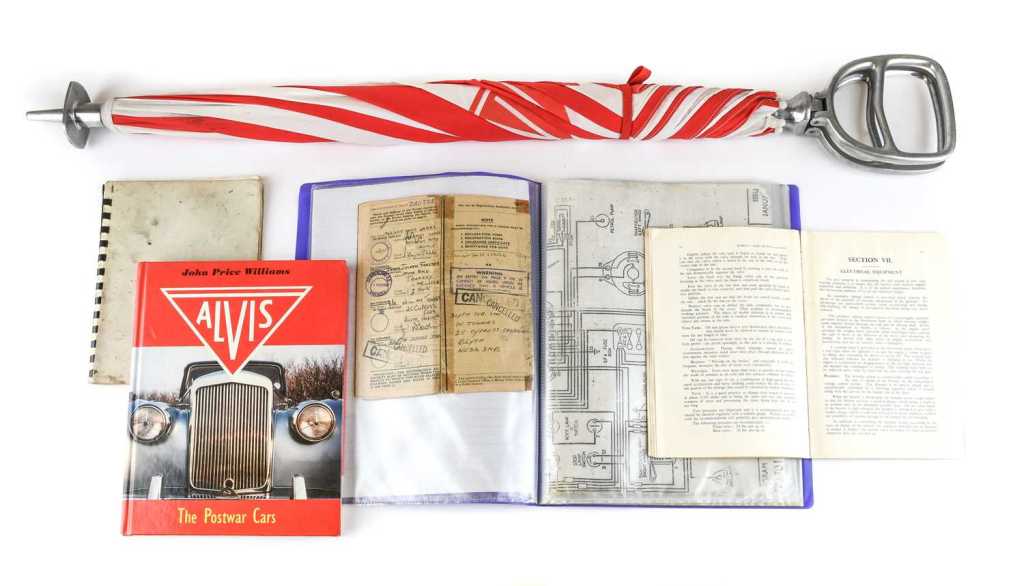
Someone was no doubt clearing out books and papers and thoughtfully put them to Auction. The good thing is that we now show 3 more owners of the car in her early days and can put the 2 pages from the Log Book with our records. Next action is to notify the owner of the car in New Zealand and make sure they are aware of this information.
Most cars are sold with their papers and it is very helpful if copies copies of old books, owners details etc. can be sent through to The Alvis Archive Trust for all Alvis cars and Alvis related matters. In the first instance for material relating to Fourteens use the email address at the end of this Post, other Alvis related items go to the main Alvis Archive Trust site, alvisarchive.com and there is a form. Best to allow some time for this unless you can steel yourself away from the interesting index and all the topics shown. The albums themselves are fascinating and perhaps you may be able to identify an unidentified car. Any original material that related to a car that was sold or scrapped in the past can be placed with the Trust’s records for safekeeping or if required passed on to the current owner if known.
When researching old taxation records The Kithead Trust hold millions of old records and can be found by contacting them at kitheadtrust.org.uk or telephoning 01905 774611 possibly only attended on Wednesdays or Thursdays. A sample of the help they can give is this letter responding to an enquiry relating to the TA 14 Tickford. Useful to get the snippet of information about JFJ 285 & 7 but no record that they were Fourteens or any trace on current DVLA website. Care needs to be taken in the ‘changes’ of owners such as in the case of house moves, marriages, divorces whereby the actual owner stays the same. The records were computerised 1977/78 so from then on it is the DVLA to whom one turns for records.
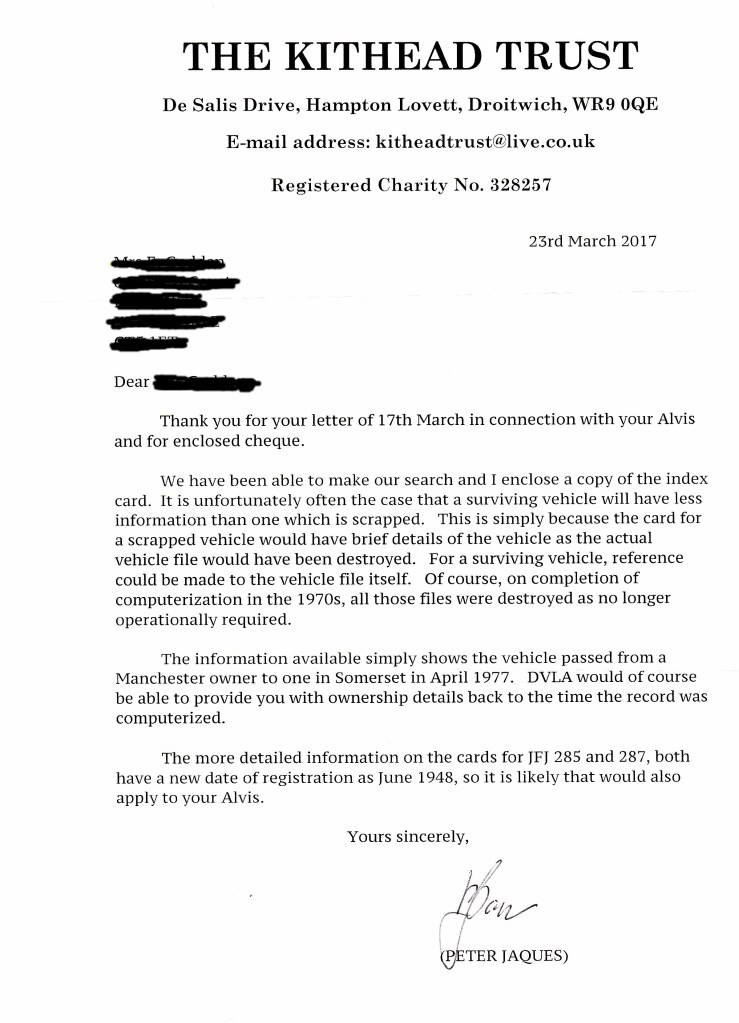
Sometimes Auction houses have sales that include some Alvis related items and 4 J &M Models have recently sold at Hampsons Auctions for £90 for 2 each, they were not Fourteens. Digressing slightly, that Auction House has a plethora of auctions covering most aspects of antiques, collectables and just about everything else. Can keep you occupied fruitlessly for hours.
Also eBay have a series of shops and one is Adsofold, adsofold.com. Plenty of nostalgic motoring items for sale including an engine plate for chassis 22377, a Tickford that is still around. £65 or offers + £5 p&p, just shows what is out there

There are quite a few models showing on the internet for various versions of Fourteens by J & M classics and they are very attractive models.
For the attention of all TA 14 owners of W.H.Gaze and Sons, Shooting Brakes.
Currently there is a rare opportunity to acquire a full set of door and window glass minus windscreen. The donor car chassis 20628 is becoming a Special having been sold from the Estate of a friend. Would cost a lot to get manufactured but available for £50 to the right car, see Abay heading above. Buyer to collect, Cambridge area.
Fourteens continues to sell and a red Mulliners Saloon chassis 22464 with superb provenance is has come up for sale in Wales. With 2 generations of the same family since 1971 she is an active well known car now looking to move on and find a new home. Priced at £12 000 she is on the road, well worth a serious look and is conveniently sited not too far off the M4 near Cardiff.
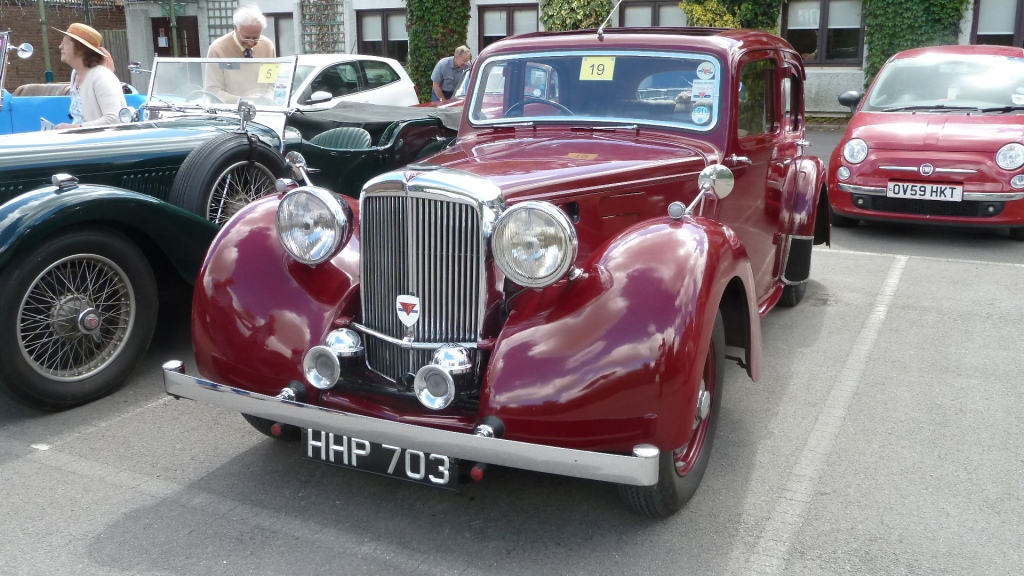
Chassis 22957, HAX 816 is another Mulliners looking for a new home and is has an asking price of £18k. On offer by The Motor Shed Ltd., Bicester, Oxfordshire, see vintageandclassiccars.co.uk.The car was off the road between 1972-1996 and has recently been restored.
Red Triangle are also offering a Mulliners Saloon as a restoration project so there are 3 possible presents for Christmas!
Looks like someone had quite a good day with Hampsons Auctioneers on the 1st October when they acquired a TA 14 Special chassis 21525 for the princely sum of £3656 including buyer’s premium. Described as running the car looks to be good fun and something that could be enjoyed.

Turning to more technical matters, with the best will in the world some areas of the Fourteen can be out of sight out of mind until the fateful day it is called upon to deliver service. The reserve tank pick up is one example of such a hidden item. Red Triangle produced a very useful prompt for attention in this area back in 2004 and it is worthy of being viewed again.

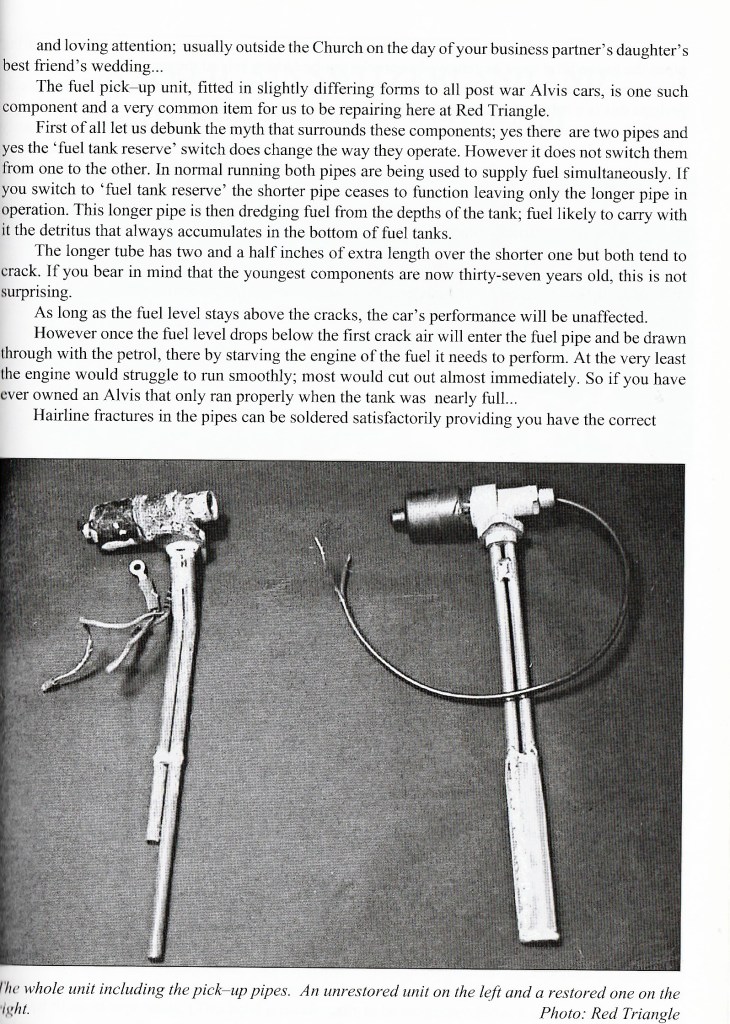

Whilst on the subject of fuel, a useful You Tube clip about synthetic fuels has been produced and shows that synthetic fuels may play a part in the future of running classic cars. Worth watching and digesting.
From down under we have a query relating to a ‘dizzy’. On the same abbreviation lines as a ‘tinnie’, this is Australian for a distributor.
Can anyone identify what car this is for as it does not appear to be the correct one for the 12/70 it resides with?
Numbers on the part are DX4A-0, type BU26 also 937 19o 405547 so if anyone can help it would be much appreciated.


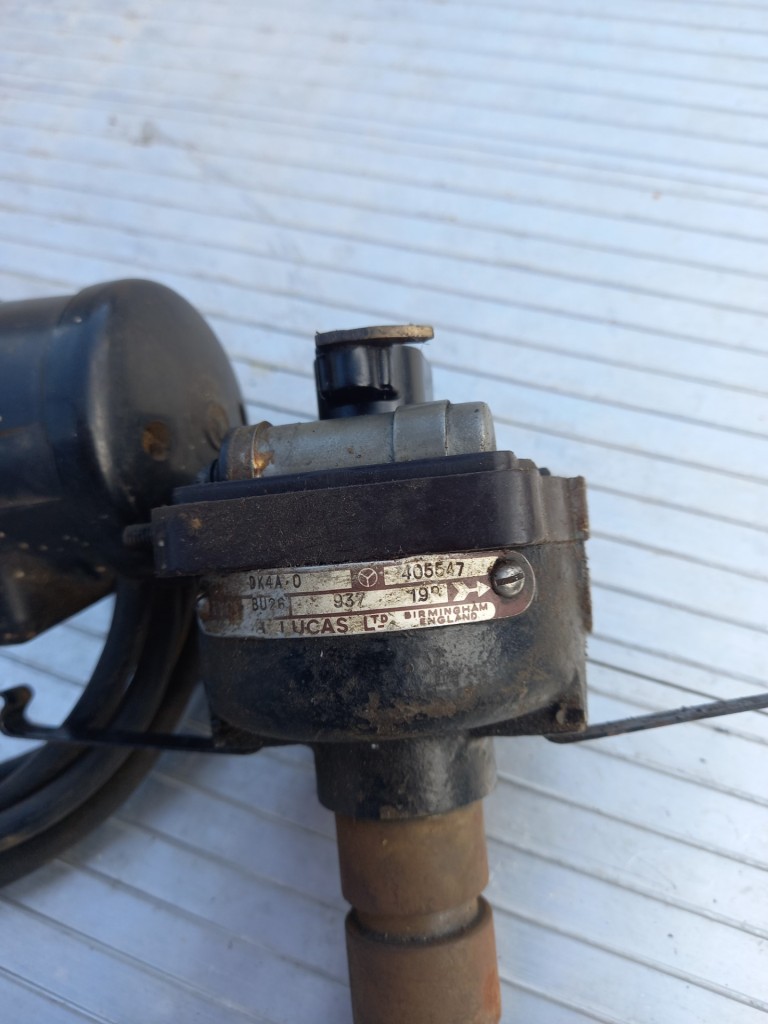
In an earlier Post there was reference to the rare Bosisto bodied Fourteen.
We now have a very interesting new Article giving a deeper insight and information about this rare car from Nick Simpson.
Alvis Fourteen, chassis 23474, the Bosisto cabriolet.
This exotic ‘Bosisto’ body is believed to be unique and was constructed on Fourteen Chassis Number 23474 and dispatched from the factory on 11/8/1949. It was first registered in early November 1950 with a Bristol registration plate NHW4. Recently a photograph of this car appeared on the Fourteen website and showed it as a used car for £975, year unknown. That was quite a lot of money for a used car in the early 1950’s so it must have been very special. A report mentions it was owned by Archie Scott-Brown, the racing driver. It was advertised as “1948 chassis, 1950 body” and the image shows it with rear wheel covers. Later 23474 appeared in the Alvis Owner Club with a Member from Harpenden, Herts in circa 1960 and in 1969 it was re-registered with BLH492H, the last time it was heard of and DVLA says it is not licensed and could not be found. Was it exported? (The DVLA also tells us the original plate, NHW4 is attached to a Red Mazda.) A later image shows extra styling extravagances including dummy ‘ports’ on the front wings, extra chrome mouldings along the sides of the body and the rear wheel covers were not present.
Bosisto, resided in the Bristol area and sketched, designed and fabricated racing and exotic car bodies. In 1947 he constructed his own 500cc racing car named ‘Buzzie’, a somewhat crude device; he was a regular competitor in the then popular 500cc formula circuit racing. Bosisto became associated with two other local and well known ‘Special’ racing car constructors and racers from the Bristol area, Joe Fry and Dick Caesar. Bristol had been an innovative centre of engineering; there were Straker-Squire cars, Bristol aero Engines, the curious Fedden car project, Bristol buses, the Brabazon air-liner and later, Rolls-Royce, Bristol Cars and the Concorde.
Bosisto was a member of the ‘500’ Club’s Technical Panel and was a pioneer in 500cc racing. His special was based on a modified Morris ‘Eight’ chassis with Morgan sliding pillar front suspension units and there was swing-axle independent rear suspension fashioned from the front suspension of a pre-war BSA three-wheeler. The engine was a Douglas (a Bristol make) horizontally opposed twin-cylinder motorcycle unit with hemispherical combustion chambers. It came from a 1930’s ‘Dirt Track’ Douglas DT5 driving through a Norton four speed gearbox. The engine being of ‘flat-twin’ layout contributed to the low centre of gravity. Buzzie was typical of the early ‘500’ cars and showed what was possible on limited means, being constructed in three weeks on the very small budget of about £35.
It was not surprising therefore when in 1947 Jim Bosisto, Dick Caesar, Joe Fry (the Fry’s Confectionary family) with help from Malcolm Sayer
(later of Jaguar styling fame), formed a modest car body-building company named the Gordano Car Company. They manufactured advanced and lightweight replacement bodies for production sportscars. This business is believed to have been located in a garage premises in Whiteladies Road in Bristol. Gordano’s first two bodies were mounted on Morgan 4/4 chassis and others were built on Allard, Alvis Fourteen and Speed Twenty chassis. There were also some Iota and Arengo 500 racers made. Bosisto raced an Arengo at Weston, in 1949. The Bosisto Alvis Fourteen body demonstrates the avant-garde and eye-catching style the firm was capable of producing.
A little-known Allard-Special came from the pen of Jim Bosisto, a lightweight body for a ‘K Type’ chassis, consisting of a tubular framework using superleggera principles achieving a weight saving of nearly 100lb over the standard K Type. Sydney Allard although not involved in the project, did support it. It is thought that possibly twelve such rebodied ‘K’ Types were constructed, although none are known to have survived. It was during this period that Bosisto’s exotic Alvis Fourteen body was created and may have been a show-car and demonstrator for the Company; it had been tuned and with twin carburettors and special gear ratios was said to be capable of 90 mph, pretty rapid for a Fourteen. Further, Alvis Speed Twenty’s are mentioned as being re-bodied although details or images of these have so far not appeared.
With success from their specialised coachwork and lightweight cars, Gordano decided to enter the motor manufacturing business to construct and market a new sportscar named The Gordano. It is said two prototypes, an open-sports and a streamlined saloon were designed and constructed in 1948 although it is not clear if the saloon reached completion. The Gordano was a sports car with the concept and chassis by Dick Caesar, an entirely new engine designed by Rodney Gordon Jones. It was a 4cylinder 1.5 litre with Cross rotary valves. The project was financed by Joe Fry while Jim Bosisto and Malcolm Sayer designed and styled the lightweight body. The open sports weighed-in at just over 750 kilograms and was temporarily equipped with a 1548cc MG engine and the saloon was to be equipped with 1767cc Lea Francis engine, presumably also temporarily until the Gordon-Jones engine was ready.
With the firm’s engineering abilities and coachwork knowledge the Gordano appeared promising and could have been a success but disaster struck and the project was abandoned when Gordon-Jones, the engine designer died in 1950 and soon after, Joe Fry, who was financing the project was killed racing at Blandford and the project came to an end.
If anyone has any more details and/or images about the Bosisto Alvises or the Gordano project, it would be great to add them to what we already have.
Nick Simpson


Finally it comes to the time to wish everyone a and that includes ‘the red nosed’ occupants of our garages.

Eileen, Terry and ‘Aunty May’
eileen4ta.tb14s@rocketmail.com
